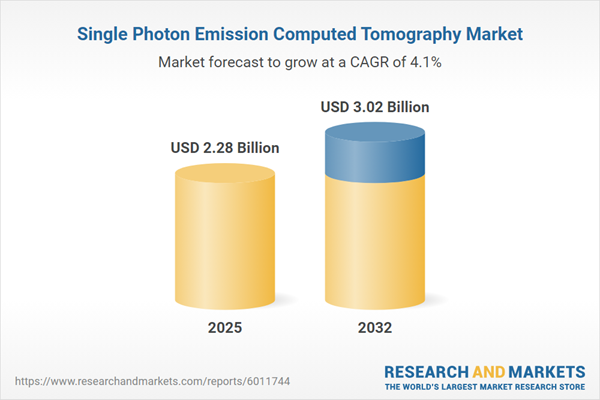Speak directly to the analyst to clarify any post sales queries you may have.
The global Single Photon Emission Computed Tomography (SPECT) market is transforming healthcare imaging, enabling providers to deliver more actionable diagnostics and streamline therapeutic planning. Leading technologies, innovative software, and evolving clinical applications are positioning SPECT systems as crucial tools in the advancement of precision medicine and patient-centered care.
Market Snapshot: SPECT Market Growth, Trends, and Outlook
The Single Photon Emission Computed Tomography market grew from USD 2.19 billion in 2024 to USD 2.28 billion in 2025. It is projected to expand at a CAGR of 4.08%, reaching USD 3.02 billion by 2032.
This steady momentum underscores growing adoption across clinical specialties, driven by accuracy demands and operational efficiencies. Robust investment in next-generation detector technologies, software enhancements, and hybrid platforms continues to accelerate innovation cycles. Healthcare institutions of all scales are integrating advanced SPECT systems to strengthen diagnostic portfolios and support evolving patient care models.Scope & Segmentation: Comprehensive Market Coverage
This research encompasses end-to-end analysis of the SPECT market, with multi-level segmentation for actionable insights. The report examines developments and trends in the following areas:
- Detector Types: CZT, NaI scintillation, solid state, germanium semiconductor, silicon photomultiplier.
- End Users: Diagnostic centers, hospitals (private, public), research institutes.
- Product Configurations: Dual head, single head, triple head systems.
- Clinical Applications: Cardiology, neurology, oncology.
- Regional Dynamics: Americas (North America: United States, Canada, Mexico; Latin America: Brazil, Argentina, Chile, Colombia, Peru), Europe, Middle East & Africa (Europe: UK, Germany, France, Russia, Italy, Spain, Netherlands, Sweden, Poland, Switzerland; Middle East: UAE, Saudi Arabia, Qatar, Turkey, Israel; Africa: South Africa, Nigeria, Egypt, Kenya), Asia-Pacific (China, India, Japan, Australia, South Korea, Indonesia, Thailand, Malaysia, Singapore, Taiwan).
- Company Developments: GE HealthCare Technologies, Siemens Healthineers, Koninklijke Philips N.V., Canon Medical Systems, Spectrum Dynamics, Digirad, Neusoft, Mediso, Shimadzu, Hitachi.
Key Takeaways: Strategic Insights for SPECT Market Stakeholders
- Adoption of solid state detector technologies is improving image resolution and throughput, supporting precision in high-demand clinical environments.
- Integration of advanced analytics and artificial intelligence is streamlining SPECT image interpretation, enabling more reliable and efficient clinical workflows.
- Demand for flexible and space-saving systems is rising among outpatient and diagnostic centers, while major hospitals favor integrated hybrid platforms for multi-modality imaging.
- Regional growth is influenced by variations in public funding, healthcare infrastructure maturity, and strategic initiatives to expand nuclear imaging access.
- Leading companies are leveraging partnerships, cloud analytics, and modular designs to address specialized end-user requirements and regulatory complexities.
Assessing the Tariff Impact: Navigating New US Policy Challenges
The imposition of United States tariffs in 2025 is introducing supply chain pressures, especially regarding critical imported detector components and electronic subsystems. Device manufacturers are reevaluating sourcing and shifting towards domestic production to offset cost volatility. These changes are influencing supplier relationships, R&D investments, and the need for more adaptable, modular engineering strategies, reinforcing industry resilience against policy-driven disruptions.
Methodology & Data Sources: Ensuring Reliability and Rigor
This report employs a blended research methodology. Primary data was gathered via in-depth interviews with senior executives at imaging system manufacturers, radiopharmaceutical providers, and healthcare decision-makers. Secondary research validated these insights using industry journals, regulatory filings, and market white papers. Triangulation, patent tracking, and expert peer review strengthened the accuracy of findings.
Why This Report Matters for Senior Decision-Makers
- Equips leaders with actionable insights into technology adoption, regulatory adaptation, and procurement planning for advanced SPECT imaging solutions.
- Supports strategic investment and partnership decisions by benchmarking market trends and competitor movements across regions and segments.
- Helps anticipate and navigate operational disruption from tariff policy shifts and supply chain realignments.
Conclusion
Single Photon Emission Computed Tomography remains central to evolving diagnostic and therapeutic paradigms. Informed decision-making, proactive innovation, and supply chain agility will enable stakeholders to sustain leadership and capture growth opportunities in this dynamic marketplace.
Additional Product Information:
- Purchase of this report includes 1 year online access with quarterly updates.
- This report can be updated on request. Please contact our Customer Experience team using the Ask a Question widget on our website.
Table of Contents
3. Executive Summary
4. Market Overview
7. Cumulative Impact of Artificial Intelligence 2025
Companies Mentioned
The companies profiled in this Single Photon Emission Computed Tomography market report include:- GE HealthCare Technologies Inc.
- Siemens Healthineers AG
- Koninklijke Philips N.V.
- Canon Medical Systems Corporation
- Spectrum Dynamics Medical Ltd.
- Digirad Corporation
- Neusoft Medical Systems Co., Ltd.
- Mediso Medical Imaging Systems Ltd.
- Shimadzu Corporation
- Hitachi, Ltd.
Table Information
| Report Attribute | Details |
|---|---|
| No. of Pages | 186 |
| Published | October 2025 |
| Forecast Period | 2025 - 2032 |
| Estimated Market Value ( USD | $ 2.28 Billion |
| Forecasted Market Value ( USD | $ 3.02 Billion |
| Compound Annual Growth Rate | 4.0% |
| Regions Covered | Global |
| No. of Companies Mentioned | 11 |









